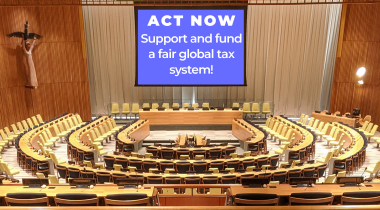
Telita Snyckers ■ Often overlooked, transparency at the tax administration level is key to holding governments accountable

“Efficient and effective tax administration”
Tax is the lifeblood of a democratic society. It’s how we fund our collective dreams and aspirations and build a better life for all.
While the legislative frameworks governing the functioning of a tax administration may differ from country to country, they typically tend to require a tax administration to be “efficient and effective” in how it pursues its goals.
Perceptions around the effectiveness of a tax administration are often simply informed by whether or not they have met their revenue targets, but of course this tells us very little about whether the administration is in fact either “efficient” or “effective”.
Transparency contributes to a better compliance climate
The holy grail for tax administrations is arguably achieving a positive “compliance climate” where enforcement measures aren’t necessary, and where taxpayers do the right thing without extensive interventions being necessary on the part of the administration. This kind of compliance culture only exists where taxpayers view the tax administration as fair, responsive, and transparent. It is a tall order for tax administrations which are often viewed as abusive – or perhaps “over-zealous” at best.
Requiring transparency is not simply about empowering civil society so it can hold our tax administrations to account. Transparency is an invaluable tool in securing a positive compliance culture, by positioning the tax system as a communal asset working for the public good; and by showcasing its staff as nation builders who should be celebrated as national heroes – not bogeymen. “Tax” should not be a dirty word, but a celebration of the people and systems that keep the lights on and the teachers paid.
That is not something that can happen in a system characterised by opacity.
Transparency of the global financial system
International tax policy has introduced measures aimed at securing greater transparency across the global financial system. This includes the automatic exchange of information; country by country reporting; and beneficial ownership registers. While these are critical to curb tax abuses, unless we know how tax administrations are using them in principle and understand how administrations are applying data insights from them in practice, their impact will be limited.
For truly impactful change we also need transparency at a tax administration level.
The importance of public oversight and insight
Some level of transparency is required for both governments and civil society to be effective. For civil society the consideration is twofold: access to information is imperative in holding governments accountable, but also to supplement weak government capacity.
With oversight agencies vastly under-capacitated, civil society plays an increasingly important role as a watchdog. Europe’s new Anti-Money Laundering Agency, for instance, will require in the region of 500 staff – double the original estimate. Its budget will have to be increased to approximately €400 million, and it may not be fully operational until 2027 because of delays in negotiations.
The Panama and Pandora Papers made abundantly clear the power of public access to beneficial ownership information.
Authorities have access to vast troves of information, but experience shows that it often takes making the information public – and a concerted effort by civil society – to make it tell a story and to secure real, systemic change.
Assessing the appropriateness of risk management strategies
More advanced administrations tend to adopt structured compliance risk management strategies for their largest taxpayers and high net worth individuals, with risk differentiation frameworks that allow them to better manage the risks from these two critical segments.
In many countries a structured, considered approach to managing high-risk taxpayers is entirely opaque (or often simply non-existent).
With the bulk of tax revenues coming from this segment, as taxpayers and as civil society, it is imperative that we have some level of assurance that our tax administrations sufficiently understand the risks – and are appropriately responding to them.
For data transparency to be effective, it needs to be part of a broader framework. This includes having access to extensive third-party data sets; sophisticated data matching and mining capabilities; complex risk rules systems that are capable of identifying outliers; an understanding of industry-specific anomalies; a robust forensic investigations capacity; a strong legal framework that gives the tax administration the powers it needs to secure information and evidence, to secure assets and to pierce the corporate veil; and a robust punitive framework.
Without some level of transparency, it is impossible to evaluate the impact and outcomes of compliance and enforcement activities, and to hold tax administrations to account.
Assessing the equitability of their relationships with large taxpayers
Beyond broader strategies, there is often little transparency in respect of engagements with large taxpayers.
Tax administrations may adopt regular meeting cycles with large taxpayers and their intermediaries, not to discuss taxpayer-specific issues, but to discuss policy issues, to identify opportunities to reduce the compliance burden on large taxpayers etc. These engagements are not without merit, but they do need to be subject to some element of transparency.
In many cases, rulings systems are entirely opaque. As a result, it is not possible to establish to what extent these administrations operate without undue influence from large taxpayers; or to assess the equitability of their tax ruling system.
Often, the terms of tax incentives, subsidies and amnesties are negotiated with no transparency.
Consistent, aggregate performance measures for tax administrations
Aside from requiring more transparency of the strategies and impact at an individual tax administration level, it is important to also develop consistent, aggregate performance measures against which tax authorities can be assessed more holistically. This could include everything from practical indicators like audit strike rates and new schemes identified, to the impact on closing tax gaps and countering illicit financial flows.
Some work is already being done in this field, for instance the Tax Administration Diagnostic Tool developed by the IMF and the World Bank, which includes measures to assess whether tax rulings are public, and whether administrations in principle have a compliance risk management program in place. However, the assessment findings are not always made public, do not focus on the management of tax abuse and illicit flows by large taxpayers or addressing systemic issues that contribute to opacity, and do not assess the impact and outcomes that are actually achieved.
Other comparative data sets are useful, but limited. The OECD’s comparative information series on tax administration is relatively comprehensive, but limited to OECD countries and some other advanced economies. The IMF’s RA-FIT comparative international survey on revenue administration has not been updated recently but could be used far more effectively in understanding comparative trends and outcomes.
This has also been a focus for the Tax Justice Network, for instance developing templates for reporting aggregate data on the automatic exchange of information; our tireless advocacy for country by country reporting; and developing indicators against which to measure progress with sustainable development goal SDG 16.4 (including eg the scale of the misalignment between where multinational companies carry out their economic activity, and where they are declare the resulting profit; and the scale of offshore wealth which is undeclared to tax authorities.)
While a focus on performance measures like these is important, it is equally important to assess whether our tax administrations are adequately staffed and resourced, with organisations like the European Public Service Union deserving far more support in their fight for tax justice.
Secrecy clauses
Tax legislation typically includes explicit safeguards to ensure that taxpayer-specific information may not be disclosed. In practice, these are often abused, being little more than an invisibility cloak for taxpayers. While the relative merits of those safeguards are up for debate, in this context what is needed is not necessarily transparency at a taxpayer level, but transparency of what tax administrations are doing in response to systemic abuses, and what impact their strategies are having on actually curbing tax abuses.
Access to government-held information
While opacity abounds, at least some developments are signalling an increase in the understanding of the importance of access to government information.
A number of jurisdictions have adopted practices that contribute to greater transparency: the countries who agree to publish the IMF’s diagnostic assessments of their administrations; the ones who publish details of the size and makeup of domestic tax gaps, like the regular studies done by the UK’s HMRC and Canada’s Revenue Agency; or countries that publish the details of how compliance risks of multinationals are managed, as they do in New Zealand.
More systemic changes are also seeing the light, for instance the European Data Strategy seeks to open up government-held information for “the public good”. The EU’s Data Governance Act, Data Act, Regulation on the Free Flow of Non-Personal Data, and Open Data Directive all encourage data sharing to ensure better decision making, using data to create value for society.
The underpinning philosophy is simple: “Data generated by the public sector as well as the value created should be available for the common good. This data has been produced with public money and should benefit society”.
Our recommendations
Tax administrations are fundamental to a functioning democracy, making transparency of their activities and outcomes non-negotiable. Our recommendations to secure greater transparency at a tax administration level include the following:
- Adopting structured – and transparent – compliance risk management strategies for large taxpayers and high net worth individuals
- Transparency of all policy-related engagements with large taxpayers and high net worth individuals
- Transparent rulings systems
- Full accounting of tax incentives, subsidies and amnesties
- Explicit risk management of enablers and intermediaries
- Developing consistent, aggregate performance measures of tax authorities, including their success or otherwise in closing tax gaps and countering illicit financial flows.
Related articles
One-page policy briefs: ABC policy reforms and human rights in the UN tax convention
Tax justice pays dividends – fair corporate taxation grows jobs, shrinks inequality

Reclaiming tax sovereignty to transform global climate finance

The “millionaire exodus” visualised
The millionaire exodus myth
10 June 2025

Uncovering hidden power in the UK’s PSC Register

Lessons from Australia: Let the sunshine in!

Vulnerabilities to illicit financial flows: complementing national risk assessments
UN Submission: A Roadmap for Eradicating Poverty Beyond Growth


